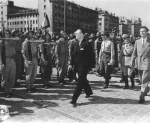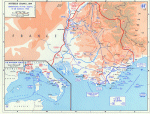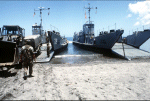Specifications:
Displacement 200 t.(lt), 375 t.(fl)
Length 134' 9"
Beam 29'
Draft 6' 1"
Speed 11 kts.
Complement 14
| Click On Image For Full Size Image |
Size | Image Description | Source |
|
|---|---|---|---|---|

1018166901 |
296k | Photo - André Diethelm reviews troops in Marseille liberated in August 1944. behind Diethelm, General de Lattre de Tassigny (in pants and uniform shirt, without jacket, looking to the right of the soldiers) and Emmanuel Astier de La Vigerie, on the right of the photo. Between the two preceding ones, behind Diethelm, in a kepi with oak leaves, General de Monsabert. Photograph taken on the wharf of Rive-Neuve on the corner with the Cours Jean-Ballard. 29 August 1944. Map - Map of southern France during Operation Dragoon, 15 to 28 April 1944. World War II Database | Tommy Trampp | |

1018166902 |
436k | |||

1018167801 |
203k | Naha (LCU-1678) and Marseilles (LCU-1669) beached on the island of Dominica wait for the equipment of the 92nd Infantry Brigade, Puerto Rico
National Guard to be offloaded during Exercise Camille, 5 March 1987.
US Army Photo by SPC Charles W. Gross |
Tommy Trampp | |

1018167802 |
209k | Naha (LCU-1678) and Marseilles (LCU-1669) beached on the island of Dominica as the equipment of the 92nd
Infantry Brigade, Puerto Rico National Guard is offloaded during Exercise Camille, 5 March 1987.
US Army Photo by SPC Charles W. Gross |
Tommy Trampp | |
There is no history available for Marseilles (LCU-1669) at NavSource
| Back to the Navsource Photo Archives Main Page | Back To The US Army Ship Index | Back To The US Army Landing Craft Utility Index |
| Comments, Suggestions, E-mail Webmaster. |
|
This page is created and maintained by Gary P. Priolo |